Introduction: A journey into the world of block printing
The Indian craft is the epitome of creativity and the Indian cultural resemblance. Block printing, an age-old Indian form of textile art is a perfect combination of artistry and tradition. A journey that speaks of the dedication, effort and innovation of skilled artisans who maintain the richness and cultural heritage still alive.
This idea of printing creativity into the fabric through a wooden block shows the remarkable ability of artisans to transform the simple fabric into alluring canvases with different designs and patterns including the elements of nature, ancient stories and mythology.
What is block Printing? Why it is so popular?
Block printing is the process of printing patterns from a wooden block onto which intricate designs and shapes are engraved. This art form is the oldest form of Indian craft and the only artistic method for imprinting vibrant designs on fabrics or paper.
This Indian craft is also known as ‘relief painting’ and is popular worldwide because of its rich heritage, highly artistic design, and the authenticity of the handmade process, which is not obtained from any other method.
It is a sustainable process that includes natural dye for imprinting patterns and resonates with the notion of an ‘eco-friendly art form’, that captivates the global market blending Indian culture with international trends.
A brief history of Block printing in India.
The art of block print which fascinates fashion enthusiasts is believed to have originated from China in the third century, 4000 years ago. After that, it flourished all over the world for its alluring designs and print. However, the story of block printing in India started in the 12th century.
Block printing has a rich history in India traced back to the Indus Valley civilization, making it one of the oldest forms of Indian textile art. The early use of the stamping technique has a resemblance to the Mughal era, a time when this craft gained prominence, flourishing mostly in the region of Rajasthan and Gujarat, each becoming the renowned hub of block printing for their unique intricate designs and vibrant patterns.
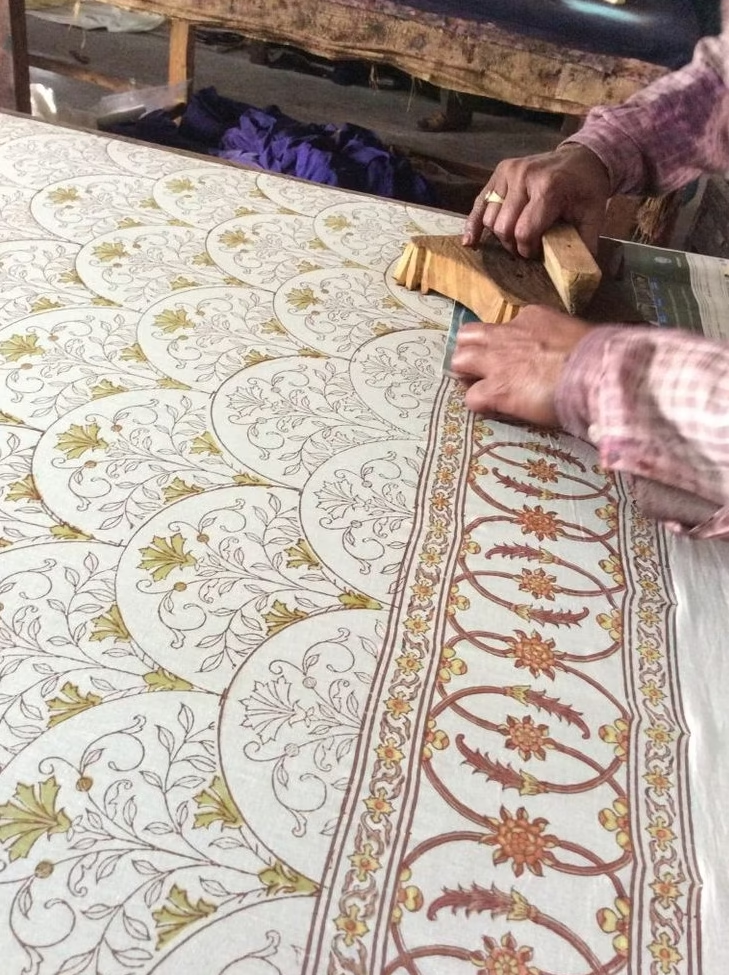
The art form quickly spreads in the other parts of the country, each one having a different style and technique giving a twist to their process of block prints on fabrics, paper or other mediums with vibrant natural colours and unique pattern combinations.
Even in a world of machine prints, this ancient craft of handmade printing is securing its place due to its highly artistic beauty and intricacy of the design. This traditional method of printing is booming worldwide gaining recognition which is a pride for the Indian culture of textile art.
The detailed creation process of block printing
Block printing is known for its beautiful prints and vibrant patterns which is done with the help of wooden blocks that are carved out with patterns and shapes to imprint on fabrics or other mediums. So, the process of block printing involves several meticulous steps that require skill and patience.
- Carving the wooden blocks
The process starts with carving designs and patterns on the wooden blocks. The blocks are made up of sycamore, slime or pearwood which are widely used for textile printing, and other varieties that are also used are deal or pine, but these are used if someone wants a cheaper option. The artisans spend hours, sometimes a day to etch floral designs, pattern combinations and geometrical shapes.
2. Preparing the fabric for imprinting
The critical step in block printing is to prepare the fabric. The fabric is washed properly and treated to remove impurities so that it can absorb the dyes evenly. A layer of padding is laid out to ensure the smooth imprinting of the design on the fabric. The padding ensures a firm base that helps the artisans to work on, preventing uneven prints and helping the dye to transfer easily and beautifully.
3. Printing the design
The master artisans use the wooden block by dipping into the dye and pressing it onto the fabric, repeating the process precisely to get the beautiful patterns carved onto the block. For multi-coloured design, multiple blocks are used making the cloth more alluring to look.
4. Finishing touches at last!
The printed fabrics are left to get dried then steamed and washed to fix the dye, making the patterns vibrant and long-lasting. Your block printing style is ready!
Famous block printing styles across India
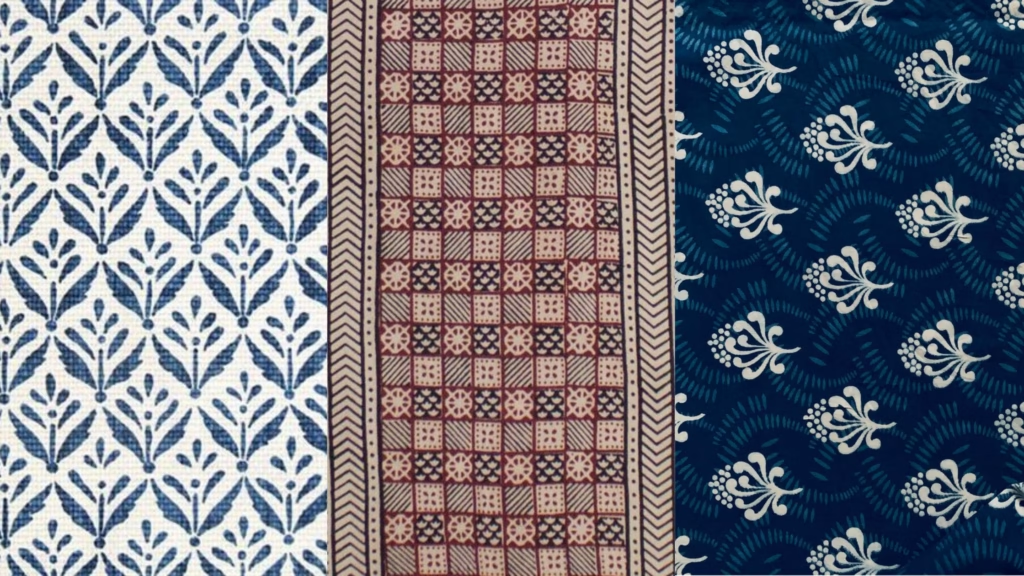
India has a rich cultural diversity, and it can be easily seen in textile Indian crafts. Among these block printing techniques is one which is diversified across many regions in India. Here are a few iconic styles:
- Sanganeri Printing (Rajasthan)
Sanganeri printing style, named after the village of Sanganer in Rajasthan, is popular for its intricate floral designs, flower motifs and paisley patterns. The fabric used in this style is ideal for summer wear as they are usually in lighter tones.
2. Bagru printing (Rajasthan)
Bagru printing is known for earthy tones and geometrical patterns. This style is eco-friendly in nature, employing natural dyes for printing, and made of vegetables and minerals. The motifs used here symbolize the elements of nature, such as leaves birds and flowers.
3. Ajrakh printing (Gujarat and Rajasthan):
Ajrakh printing is celebrated for its symmetrical designs and vibrant indigo hues. Ajrakh is printing as ekpuri (single-sided) and bipuri (double-sided). This style requires determination and patience as it involves multiple times of dyeing and printing, generating layered designs on fabrics.
4. Kalamkari (Andra-Pradesh)
Kalamkari is a traditional form of art which is popular for its intricate design that is a vivid depiction of mythological tales and embraces the art of storytelling through printing fabrics.
5. Batik (West-Bengal)
Batik style reflects the blend of traditional techniques with modern trends by combining wax-resist techniques with block printing to embrace the cultural identity of the region. This brings the bold design and pattern onto the fabric that sets well with the modernized form of styling among this generation.
Challenges facing by the block printing Industries
Block printing is booming all over the country but despite its timeless appeal, there are challenges and obstacles faced by the block printing industries.
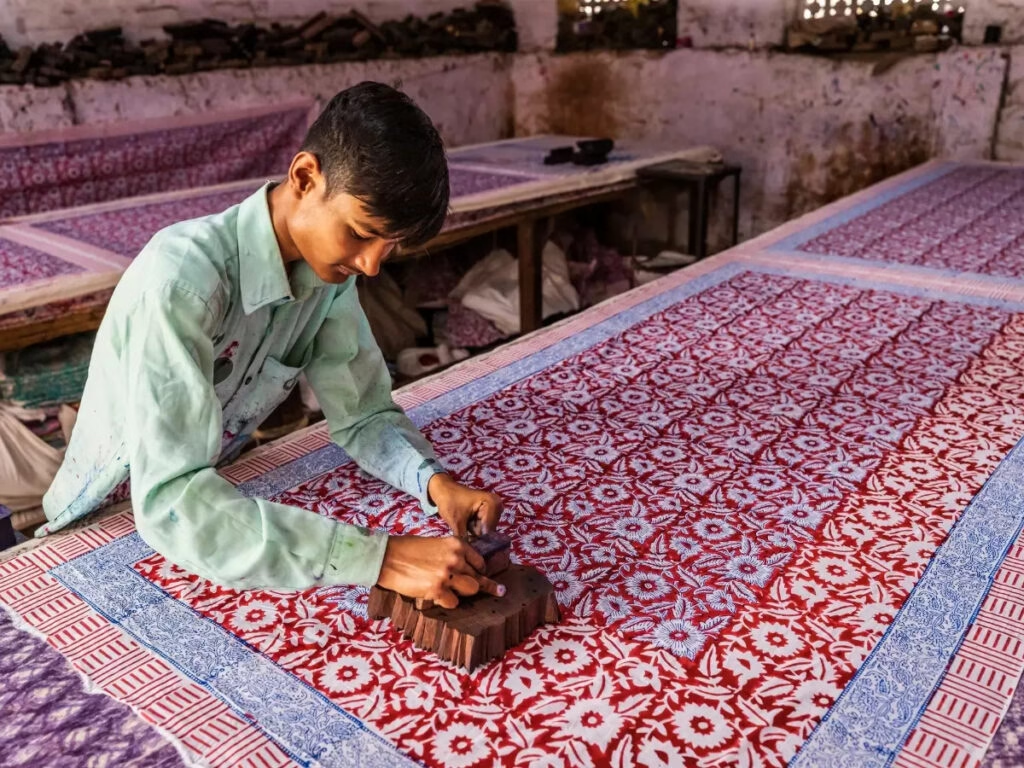
Competition with machine-made fabrics:
In today’s fast-paced world, everything needs to be done quickly. The process of block printing takes time to produce the high-quality artistry but due to the competition with machine-made fabrics, where the mass-production of textile with cheaper rates and more accessibility, the demand for hand-made block prints has decreased. This shift led a greater impact on traditional artisans as they struggle to compete with the machines and a market dominated by speed and cost-efficiency.
Lack of young and skilled artisans:
Another critical challenge in block printing industry is a lack of young and dedicated artisans. This method is a labor-intensive craft and requires determined amount of time and dedication to master the skills of block print and in today’s world the young generation wants to move away to urban areas for high-paying jobs and they don’t want to settle with the traditional form of labor.
Rising material costs:
The cost of printing materials is rising which is yet another challenges in this industry. The important elements of block printing such as natural dyes, colors and high-quality fabrics have become highly expensive, making it difficult for artisans to maintain the sustainability of their work.
Due to all these factors, many artisans are forced to compromise on different factors or abandon the craft altogether which not only affect the small-business artisans’ livelihood but also put the future of this traditional culture of Indian craft into jeopardy.
How can we support this traditional form of textile craft?
The future of this traditional artistry is in our hands that needs to be supported and prevented from getting disappear. Supporting block printing isn’t just about buying high-quality fabrics but also preserving the rich piece of history.
In today’s fashion industry where everything is just fast-paced trends and easily disposable clothes, there are movements for sustainability and quality. Block printing is what aligns with seamlessly with this echos. The timeless traditional art of block printing leaves a long-lasting impression, and it maintains the quality of fabric design, ensuring an eco-friendly process by using natural dyes for imprinting, embracing sustainability.
We can help to preserve this cultural tradition by spreading awareness and educating people about its beauty and significance. Influencing people to shop locally, directly from the artisans or from the platforms that works with them.
Incorporating block prints in fashion, choosing block-printed clothes and accessories can also support in managing and maintain this Indian art. Appreciate the art and artisans can bring a great impact in breaking the challenges faced by block printing industry.
Incorporating the block printing into Modern Fashion and Accessories
Modern fashion is all about being trendy everywhere, but the best part is people are expressing their interest in sustainability and cultural fashion. To embrace this versatile Indian form of art, one can adapt this style in many ways by bringing changes in their modern lifestyle. Block printing seamlessly bridges between modernity and tradition and offers countless ways of incorporating this art form into your fashion and lifestyle.
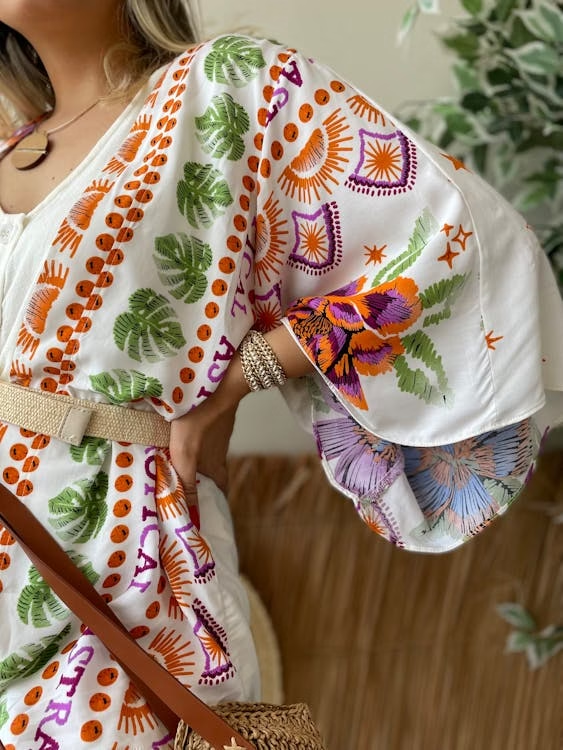
In the realm of fashion, accessories with block-printed designs are trending and gaining immense popularity. Pairing up block-print dresses, kurtis and sarees with block-printed sneakers and handbags has become a modernized way of styling. Handmade accessories with beautiful prints are a unique alternative to mass-produced items.
Even in the collection for men, pocket squares and block-printed shirts are subtle yet give an attractive look to their wardrobe. This kind of shirt is popular among the men of Gujarat and Rajasthan. Beyond clothing, scarfs, shawls and stoles with block-printed designs are quite fashionable for those who like to go bold and tasteful with their style.
Home decor items with block-printed bed sheets, curtains, and pillow covers add an elegant touch to the interior. Interior design enthusiasts always opt for handmade items and the designs and patterns of block-printing bring a rustic charm to interiors.
Block printing has a limitless potential for innovation inspiring designers, fashion lovers and consumers alike, making a relevance in the modern fashion industry. Some platforms support the art and the craftsmen’s efforts by promoting the designs and items on their sites and social media, making fabrics easily available to consumers.
Why is a block printing considered as a symbol of cultural heritage?
Block printing resembles the significance of cultural heritage and India’s richness. Each intricate shape, vibrant pattern and colorful pallet engraved on a block that imprints on a fabric reflects a story of traditions and beauty of the region of a county such as floral motifs of Jaipur and geometrical designs of Gujarat. It is a living narrative of Indian history, whose design is an inspiration from festivals, rituals and culture.
Passing down from generation to generation, the art form connects the artisans to their roots and embracing this Indian textile art is a respect and appreciation towards the craftsmen for preserving the cultural tapestry of India.
Preserving the legacy of Timeless Indian craft: Block printing
Block printing is much more than just a craft; it’s a legacy of creativity, storytelling, and traditional culture. The perseverance of block printing involves meticulous effort, maintaining its physical integrity and cultural resemblance. As the world is evolving towards fast fashion and machine-made textiles, preserving and celebrating this ancient Indian craft becomes more critical than ever, this way we can maintain cultural richness and artistic creativity.
The fashion of block-printed clothes is influencing the wardrobe of many fashion-industries people and moving towards these prints fabrics can not only bring the touch of creativity and unique designs to your closet but also support the hardworking artisans who are dedicated towards keeping this cultural heritage alive.
The initiative taken for promoting block printing and handmade products is quite impressive. Certain events and exhibitions like the Dastkar and Kala Ghoda art festivals often showcase handmade block-printed items directly from the artisans to support the genuine craftsmen’s livelihood. They also host workshops and classes so the visitors can learn and understand the techniques and cultural resemblance of block printing, ensuring that the next generation can learn and appreciate the beauty of this rich and timeless tradition!
For further reading on significance of block printing, you can visit these useful resources:
Check out our Blog Page on Traditional Indian art.

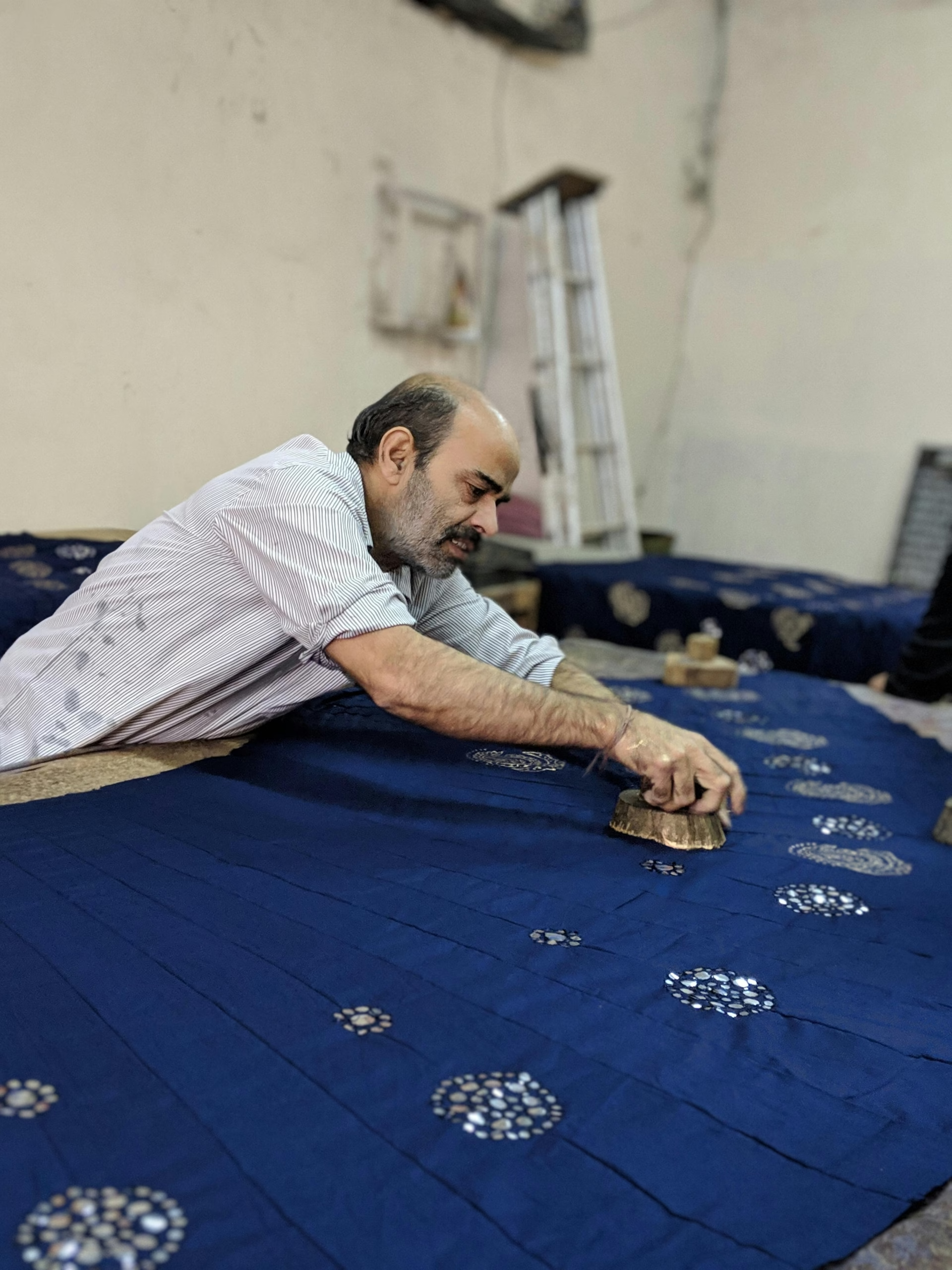

Leave a Reply